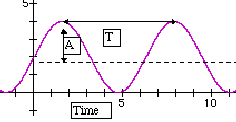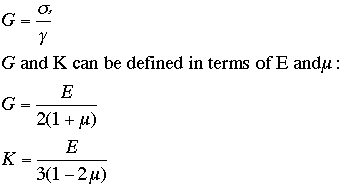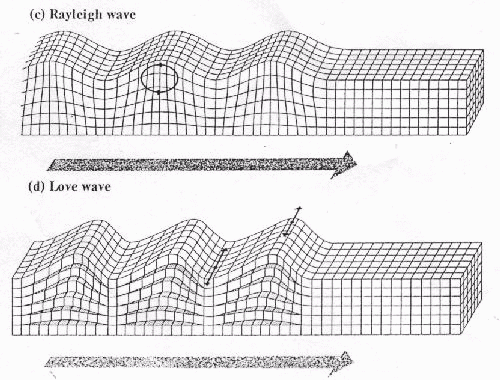
EARTHQUAKE SEISMOLOGY I
BY
KIAN H CHONG
Modified by
LAI LEE

Contents
Introduction
Seismology is the study of the passage of elastic waves through the
earth. Earthquake seismology is the best tool to study the interior of the
earth. When an earthquake or explosion occurs, part of the energy released is as
elastic waves that are transmitted through the earth. The waves are then
detected and recorded by seismograms, which measure, amplify and record
the motion of the ground. The information is then used to determine earthquake
locations, the subsurface structures and etc.

This pendulum-mounted seismograph records
horizontal motion. The mass is coupled to the Earth by means of a pendulum and a
pivot is attached to a rod to constrain the mass to move in the horizontal
direction only.

The spring-mounted seismograph records the vertical ground
motion. A spring is attached to the mass which is connected to a rod. The rod is
attached to a pivot to constrain the mass to move in an up and down direction
only.
Basic Physics
There is some basic terminology and physics that describe the various
aspects of wave form and motion. The wavelength ( ) is the
distance between two adjacent points on the wave that have similar
displacements, anone wavelength is the distance between successive crest.
Amplitude (A) of the wave is the maximum displacement of the particle motions,
or the height of the ripple crest. Period (T) is the time it takes for two
successive waves to pass a reference point or the motion to complete one cycle.
The cycle of seismic waves or repetitions in a given unit of time is called
frequency (f). Frequency and period are related by this relationship:
) is the
distance between two adjacent points on the wave that have similar
displacements, anone wavelength is the distance between successive crest.
Amplitude (A) of the wave is the maximum displacement of the particle motions,
or the height of the ripple crest. Period (T) is the time it takes for two
successive waves to pass a reference point or the motion to complete one cycle.
The cycle of seismic waves or repetitions in a given unit of time is called
frequency (f). Frequency and period are related by this relationship:
f = 1 / T [unit: hertz (Hz) or 1/s]
The speed in which the wavefront or ripple crest travel can
be detected if the time the wavefront takes to reach a known distance is
recorded:
V = distance / time [unit: m/s]
Or if wavelength and frequency are known:


Elastic
Coefficients
Elasticity is the behavior of a
rock that has been subjected to a stress (force/area), a change in shape
(strain), and the rock returns to its original shape. The manner and speed of
seismic waves travel through material is controlled by their elastic properties.
The linear relationship between applied stress  and resulting
strain
and resulting
strain  is:
is:

E is the constant of proportionality called Young's
modulus. Elongation are measured for each direction, and their ratio is referred
to as Poisson's ratio ( ):
):


The original volume ( ) change to final
volume (
) change to final
volume ( ) when compared to the pressure change is called bulk modulus (
) when compared to the pressure change is called bulk modulus ( ). The
bulk modulus is a measure of the incompressibility of the material:
). The
bulk modulus is a measure of the incompressibility of the material:

When deforming a solid state by simple shear, a shear
strain ( ) is induced by applying a shear stress
) is induced by applying a shear stress  . The ratio of
these quantities is the rigidity modulus (G):
. The ratio of
these quantities is the rigidity modulus (G):

Seismic Waves

There are two different types of body waves and two surface
waves.
Body Waves
Body waves are seismic waves that travel through the body of the earth.
Body waves are reflected and transmitted at interfaces where seismic velocity
and/or density change, and they obey Snell's law. The two different types of
body waves are:
- P-Waves (P stands for primary or pressure or push-pull).
These waves are also called longitudinal waves or compressional waves due to
particle compression during their transport. These waves involve compression
and rarefaction of the material as the wave passes through is but not
rotation. P-wave is transmitted by particle movement back and forth along the
direction of propagation of the wave. The most correct description of P-waves
is it is a dilational or irrotational waves. P-waves has the greatest speed
and appears first on seismograms.
- S-Waves (S stands for secondary or shear or shake). Also
known as transverse waves, because particle motions are transverse to the
direction of movement of the wavefront, or perpendicular to the ray. These
waves involve shearing and rotation of the material as the wave passes through
it, but not volume change. The most correct description of S-waves is it is a
rotational or equivolumnar wave. S-waves have speeds less than P-waves, and
appear on seismograms after P-waves.

Surface Waves
Surface waves are seismic waves that are guided along the surface of the
earth and the layers near the surface. These waves do not penetrate the deep
interior of the earth, and are normally generated by shallow earthquakes
(nuclear explosions do not generate these surface waves!). Surface waves are
larger in amplitude and longer in duration than body waves. These waves arrive
at seismograph after the arrival of P- and S-waves because of their slower
velocities. The two different surface waves are:
- Rayleigh waves or descriptively called "ground roll" in
exploration seismology. The particle motion of this wave is confined to a
vertical plane containing the direction of propagation and retrogrades
elliptically. The particle displacements are greatest at the surface and
decrease exponentially downward. Rayleigh waves shows dispersion, and its
velocity is not constant but varies with wavelength. This wave is similar to
how ocean waves propagate.
- Love waves(named for A.E.H. Love, who discovered them)
travel by a transverse motion of particles that is parallel to the ground
surface. This wave is somewhat similar to S-waves. Love waves occur when there
is a general increase of S- wave velocity with depth. The particle motion is
transverse and horizontal. Generally, Love waves velocities are greater than
Rayleigh waves. Love waves arrives first before Rayleigh waves on seismograph.

Seismic Wave Velocities

The velocities of P- and S-waves are given below in
terms of the density ( ) and elastic coefficients of a material:
) and elastic coefficients of a material:

If we note that the bulk modulus (K) and
the rigidity modulus (G) are always positive and recall that Poisson's ratio
( ) is less than or equal to 0.5, then evidently the velocity of P-waves
must always be greater than S-waves by a big factor. Shear waves (S-waves)
cannot propagate through liquid. This is evident when we substitute G = 0 for
liquids, then the velocity of S-waves goes to zero. This is how it was
determined that the outer core consists of liquid.
) is less than or equal to 0.5, then evidently the velocity of P-waves
must always be greater than S-waves by a big factor. Shear waves (S-waves)
cannot propagate through liquid. This is evident when we substitute G = 0 for
liquids, then the velocity of S-waves goes to zero. This is how it was
determined that the outer core consists of liquid.
There are a few general
rules to the velocity ranges of common materials:
- Unsaturated sediments have lower values than saturated
sediments.
- Unconsolidated sediments have lower values than consolidated
sediments.
- Velocities are very similar in saturated, unconsolidated
sediments.
- Weathered rocks have lower values than similar rocks that
are unweathered.
- Fractured rocks have lower values than similar rocks that
are unfractured.
Below is a list of velocity estimation of common
waves:

Earthquake Locations
The earthquake
focus or hypocenter is the point where the earthquake originated. This location
is specified bylatitude, longitude, and depth beneath the surface.
 The location of earthquakes are determined from at least three
seismic stations. Given a single seismic station, the seismogram records will
yield a measurement of the S-P time. This will allow the distance between the
station and the event to be located. Multiply the seconds of S-P time by the
velocity of the waves gives the distance of the epicenter, the point on the
surface directly above the focus. Drawing a circle on a map around the station's
location, with a radius equal to the distance, shows all possible locations for
the event. With the S-P time from a second station, the circle around that
station will narrow the possible locations down to two location. With a third
station's S-P time that one can draw a third circle that should identify which
of the two previous possible points is the real one. The diagram below
illustrates this method.
The location of earthquakes are determined from at least three
seismic stations. Given a single seismic station, the seismogram records will
yield a measurement of the S-P time. This will allow the distance between the
station and the event to be located. Multiply the seconds of S-P time by the
velocity of the waves gives the distance of the epicenter, the point on the
surface directly above the focus. Drawing a circle on a map around the station's
location, with a radius equal to the distance, shows all possible locations for
the event. With the S-P time from a second station, the circle around that
station will narrow the possible locations down to two location. With a third
station's S-P time that one can draw a third circle that should identify which
of the two previous possible points is the real one. The diagram below
illustrates this method.

In
practice, this is not as simple because the earth is not flat nor homogenous.
The P- and S- wave velocities are not globally constant. The focal depth is also
unknown. Focal depths are determined from the measurement in travel time between
the P phase and the reflected P-wave at the earth's surface. Most earthquakes
are shallow and none have been detected below a depth of 700 km.
Magnitude and Intensity
Earthquake magnitude is most commonly reported using the
Richter
scale magnitude , named after geophysicist Charles F. Richter,
who developed it. The magnitude number is assigned to an earthquake on the basis
of amount of grond displacement, which is measured by a seismograph. Since the
Richter scale is logarithmic, then for every unit increase in Richter magnitude,
ground displacement increases by a factor of ten, while energy release increases
by a factor of thirty.
Another way of describing the size of an earthquake is by the
earthquake's intensity which measures the effects on humans on surface features.
The surface effects produced by an earthquake of a given magnitude vary
considerably as a result of such factors as local geologic conditions, quality
of construction and distance from epicenter. The most widely applied intensity
scale in the U.S. is the Modified Mercalli Scale. The following is the abridged
version of the Modified Mercalli Scale:
|
INTENSITY ----DESCRIPTION |
|
I----Not Felt.
II----Felt by persons at rest on uppper floors.
III----Felt indoors---hanging objects swing. Vibration like
passing of light trucks.
IV----Vibration like passing of heavy trucks. Standing automobile
rock. Windows, dishes, and doors rattle; wooden walls or frame may
creak.
V----Felt outdoors. Sleepers wakened. Liquids disturbed, some
spilled; small objects may be moved or upset; doors swing; shutters and
pictures move.
VI----Felt by all; many frightened. People walk unsteadily;
windows and dishes broken; objects knocked off shelves, pictures off
walls. Furniture moved or overturned; weak plaster cracked. Small bells
ring. Trees and bushes shaken.
VII----Difficult to stand. Furniture broken. Damage to weak
materials, such as adobe; some cracking of ordinary masonry. Fall of
plaster, loose bricks, and tile. Waves on ponds; water muddy; small slides
along sand or gravel banks. Large bells ring.
VIII----Steering automobiles affected. Damage to and partial
collapse of ordinary masonry. Fall of chimneys, towers. Frame houses moved
on foundations if not bolted down. Changes in flow of springs and
wells.
IX----General panic. Frame structure shiffted off foundations if
not bolted down; frames cracked. Serious damage even to partially
reinforced masonry. Underground pipes broken; reserviors damaged.
Conspicuous cracks in ground.
X----Most masonry and frame structure destoryed with their
foundations. Serious damage to dams and dikes; large landslides. Rails
bent slightly.
XI----Rails bent greatly. Underground pipelines out of
service.
XII----Damage nearly total. Large rock masses shifted; objects
thrown into the air. |
Reference
1.
Burger, Robert H., 1992. Exploration Geophysics of the Shallow Surface.
Prentice Hall Inc. New Jersey. 7-19.
2. Fowler, C.M.R., 1995. The Solid
Earth: An Introduction to Global Geophysics. Cambridge University Press. New
York. 76-96.
Illustration."http://www.seismo.unr.edu/ftp/pub/louie/class/100/seismic-waves.html"
3.
Beck, A.E. Physical Principles of Exploration Methods: An Introductory Text
For Geology and Geophysics Students. New York: Wiley, c 1981
UCD Phys Sci TN 269.B387 1981
4. Sharma, P. Vallabh. Geophysical Methods in Geology,
2nd ed. New York.
UCD Phys Sci QE 501.3.S48 1986
5. Press, Frank; Siever, Rfaymond. Earth, 4th ed. New
York: W.H. Freeeman and Company, 1985
6. Montgomery, Carla W. Environmental Geology, 3rd ed.
Wm. C. Brown Publishers. 1991
.gif)
Link
to Earthquake Seismology II
WWW Seismology
Links:
Send comments and suggestions to:  Kinnosaurous
Kinnosaurous 





![]() ) is the
distance between two adjacent points on the wave that have similar
displacements, anone wavelength is the distance between successive crest.
Amplitude (A) of the wave is the maximum displacement of the particle motions,
or the height of the ripple crest. Period (T) is the time it takes for two
successive waves to pass a reference point or the motion to complete one cycle.
The cycle of seismic waves or repetitions in a given unit of time is called
frequency (f). Frequency and period are related by this relationship:
) is the
distance between two adjacent points on the wave that have similar
displacements, anone wavelength is the distance between successive crest.
Amplitude (A) of the wave is the maximum displacement of the particle motions,
or the height of the ripple crest. Period (T) is the time it takes for two
successive waves to pass a reference point or the motion to complete one cycle.
The cycle of seismic waves or repetitions in a given unit of time is called
frequency (f). Frequency and period are related by this relationship:![]()







![]() ) and elastic coefficients of a material:
) and elastic coefficients of a material:
![]() ) is less than or equal to 0.5, then evidently the velocity of P-waves
must always be greater than S-waves by a big factor. Shear waves (S-waves)
cannot propagate through liquid. This is evident when we substitute G = 0 for
liquids, then the velocity of S-waves goes to zero. This is how it was
determined that the outer core consists of liquid.
) is less than or equal to 0.5, then evidently the velocity of P-waves
must always be greater than S-waves by a big factor. Shear waves (S-waves)
cannot propagate through liquid. This is evident when we substitute G = 0 for
liquids, then the velocity of S-waves goes to zero. This is how it was
determined that the outer core consists of liquid.


.gif)
![]() Kinnosaurous
Kinnosaurous ![]()